Misrepresentation in Contract Law
VerifiedAdded on 2023/01/16
|9
|2569
|1
AI Summary
This article discusses the concept of misrepresentation in contract law and its implications. It explains the elements required to establish misrepresentation and the rights of the innocent party. The article also provides case references and legal principles related to misrepresentation.
Contribute Materials
Your contribution can guide someone’s learning journey. Share your
documents today.

Commercial Law
Secure Best Marks with AI Grader
Need help grading? Try our AI Grader for instant feedback on your assignments.
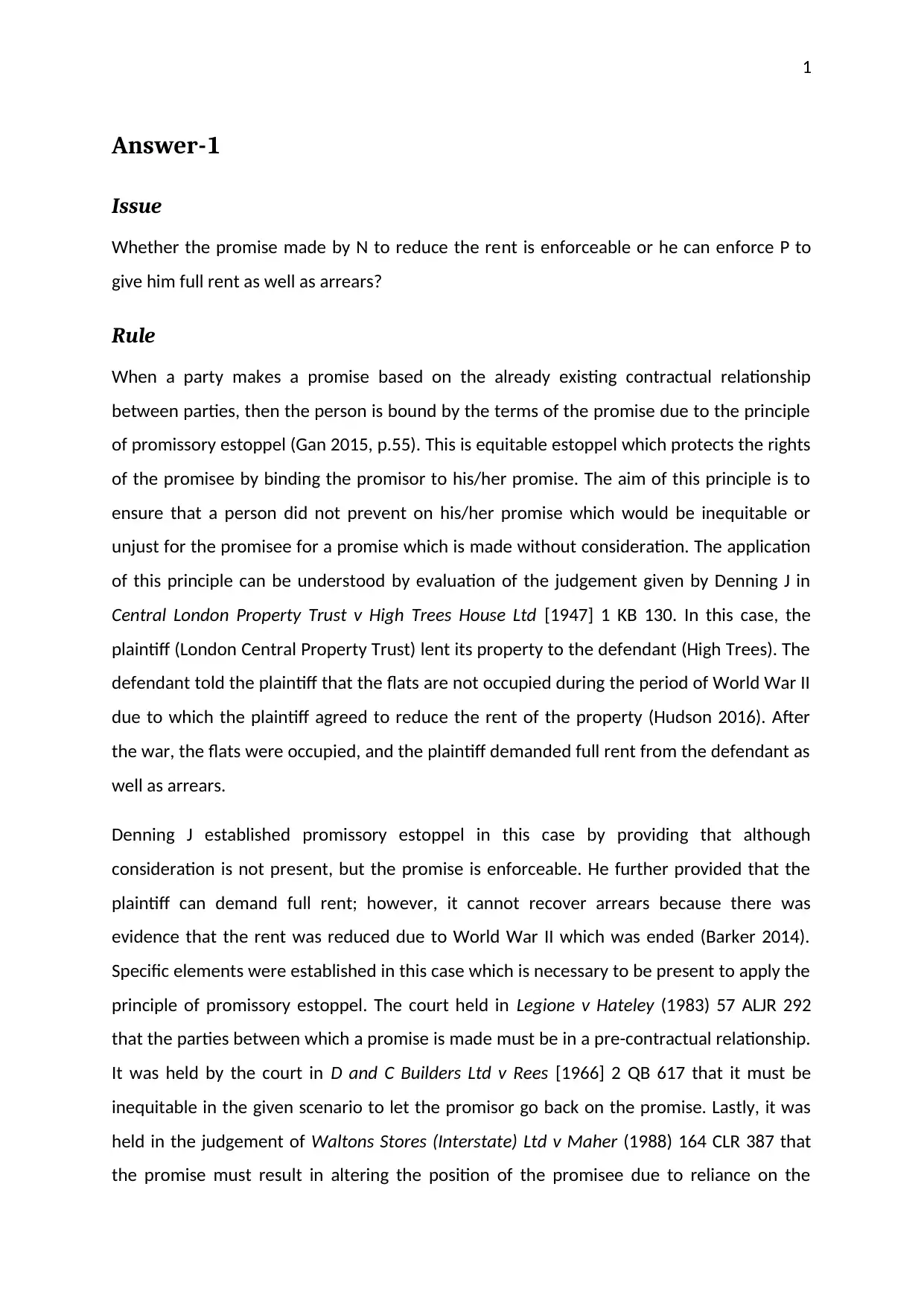
1
Answer-1
Issue
Whether the promise made by N to reduce the rent is enforceable or he can enforce P to
give him full rent as well as arrears?
Rule
When a party makes a promise based on the already existing contractual relationship
between parties, then the person is bound by the terms of the promise due to the principle
of promissory estoppel (Gan 2015, p.55). This is equitable estoppel which protects the rights
of the promisee by binding the promisor to his/her promise. The aim of this principle is to
ensure that a person did not prevent on his/her promise which would be inequitable or
unjust for the promisee for a promise which is made without consideration. The application
of this principle can be understood by evaluation of the judgement given by Denning J in
Central London Property Trust v High Trees House Ltd [1947] 1 KB 130. In this case, the
plaintiff (London Central Property Trust) lent its property to the defendant (High Trees). The
defendant told the plaintiff that the flats are not occupied during the period of World War II
due to which the plaintiff agreed to reduce the rent of the property (Hudson 2016). After
the war, the flats were occupied, and the plaintiff demanded full rent from the defendant as
well as arrears.
Denning J established promissory estoppel in this case by providing that although
consideration is not present, but the promise is enforceable. He further provided that the
plaintiff can demand full rent; however, it cannot recover arrears because there was
evidence that the rent was reduced due to World War II which was ended (Barker 2014).
Specific elements were established in this case which is necessary to be present to apply the
principle of promissory estoppel. The court held in Legione v Hateley (1983) 57 ALJR 292
that the parties between which a promise is made must be in a pre-contractual relationship.
It was held by the court in D and C Builders Ltd v Rees [1966] 2 QB 617 that it must be
inequitable in the given scenario to let the promisor go back on the promise. Lastly, it was
held in the judgement of Waltons Stores (Interstate) Ltd v Maher (1988) 164 CLR 387 that
the promise must result in altering the position of the promisee due to reliance on the
Answer-1
Issue
Whether the promise made by N to reduce the rent is enforceable or he can enforce P to
give him full rent as well as arrears?
Rule
When a party makes a promise based on the already existing contractual relationship
between parties, then the person is bound by the terms of the promise due to the principle
of promissory estoppel (Gan 2015, p.55). This is equitable estoppel which protects the rights
of the promisee by binding the promisor to his/her promise. The aim of this principle is to
ensure that a person did not prevent on his/her promise which would be inequitable or
unjust for the promisee for a promise which is made without consideration. The application
of this principle can be understood by evaluation of the judgement given by Denning J in
Central London Property Trust v High Trees House Ltd [1947] 1 KB 130. In this case, the
plaintiff (London Central Property Trust) lent its property to the defendant (High Trees). The
defendant told the plaintiff that the flats are not occupied during the period of World War II
due to which the plaintiff agreed to reduce the rent of the property (Hudson 2016). After
the war, the flats were occupied, and the plaintiff demanded full rent from the defendant as
well as arrears.
Denning J established promissory estoppel in this case by providing that although
consideration is not present, but the promise is enforceable. He further provided that the
plaintiff can demand full rent; however, it cannot recover arrears because there was
evidence that the rent was reduced due to World War II which was ended (Barker 2014).
Specific elements were established in this case which is necessary to be present to apply the
principle of promissory estoppel. The court held in Legione v Hateley (1983) 57 ALJR 292
that the parties between which a promise is made must be in a pre-contractual relationship.
It was held by the court in D and C Builders Ltd v Rees [1966] 2 QB 617 that it must be
inequitable in the given scenario to let the promisor go back on the promise. Lastly, it was
held in the judgement of Waltons Stores (Interstate) Ltd v Maher (1988) 164 CLR 387 that
the promise must result in altering the position of the promisee due to reliance on the
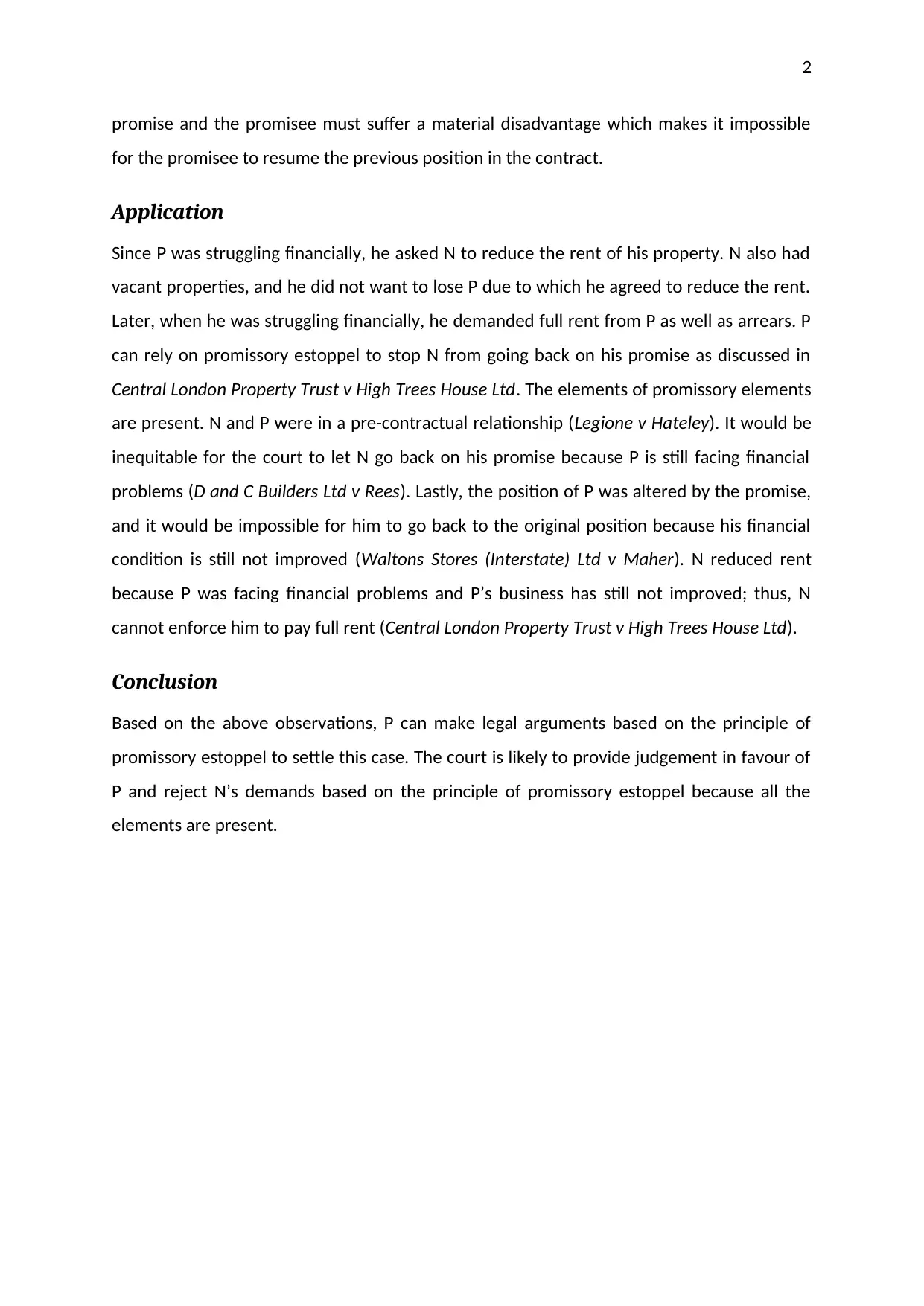
2
promise and the promisee must suffer a material disadvantage which makes it impossible
for the promisee to resume the previous position in the contract.
Application
Since P was struggling financially, he asked N to reduce the rent of his property. N also had
vacant properties, and he did not want to lose P due to which he agreed to reduce the rent.
Later, when he was struggling financially, he demanded full rent from P as well as arrears. P
can rely on promissory estoppel to stop N from going back on his promise as discussed in
Central London Property Trust v High Trees House Ltd. The elements of promissory elements
are present. N and P were in a pre-contractual relationship (Legione v Hateley). It would be
inequitable for the court to let N go back on his promise because P is still facing financial
problems (D and C Builders Ltd v Rees). Lastly, the position of P was altered by the promise,
and it would be impossible for him to go back to the original position because his financial
condition is still not improved (Waltons Stores (Interstate) Ltd v Maher). N reduced rent
because P was facing financial problems and P’s business has still not improved; thus, N
cannot enforce him to pay full rent (Central London Property Trust v High Trees House Ltd).
Conclusion
Based on the above observations, P can make legal arguments based on the principle of
promissory estoppel to settle this case. The court is likely to provide judgement in favour of
P and reject N’s demands based on the principle of promissory estoppel because all the
elements are present.
promise and the promisee must suffer a material disadvantage which makes it impossible
for the promisee to resume the previous position in the contract.
Application
Since P was struggling financially, he asked N to reduce the rent of his property. N also had
vacant properties, and he did not want to lose P due to which he agreed to reduce the rent.
Later, when he was struggling financially, he demanded full rent from P as well as arrears. P
can rely on promissory estoppel to stop N from going back on his promise as discussed in
Central London Property Trust v High Trees House Ltd. The elements of promissory elements
are present. N and P were in a pre-contractual relationship (Legione v Hateley). It would be
inequitable for the court to let N go back on his promise because P is still facing financial
problems (D and C Builders Ltd v Rees). Lastly, the position of P was altered by the promise,
and it would be impossible for him to go back to the original position because his financial
condition is still not improved (Waltons Stores (Interstate) Ltd v Maher). N reduced rent
because P was facing financial problems and P’s business has still not improved; thus, N
cannot enforce him to pay full rent (Central London Property Trust v High Trees House Ltd).
Conclusion
Based on the above observations, P can make legal arguments based on the principle of
promissory estoppel to settle this case. The court is likely to provide judgement in favour of
P and reject N’s demands based on the principle of promissory estoppel because all the
elements are present.
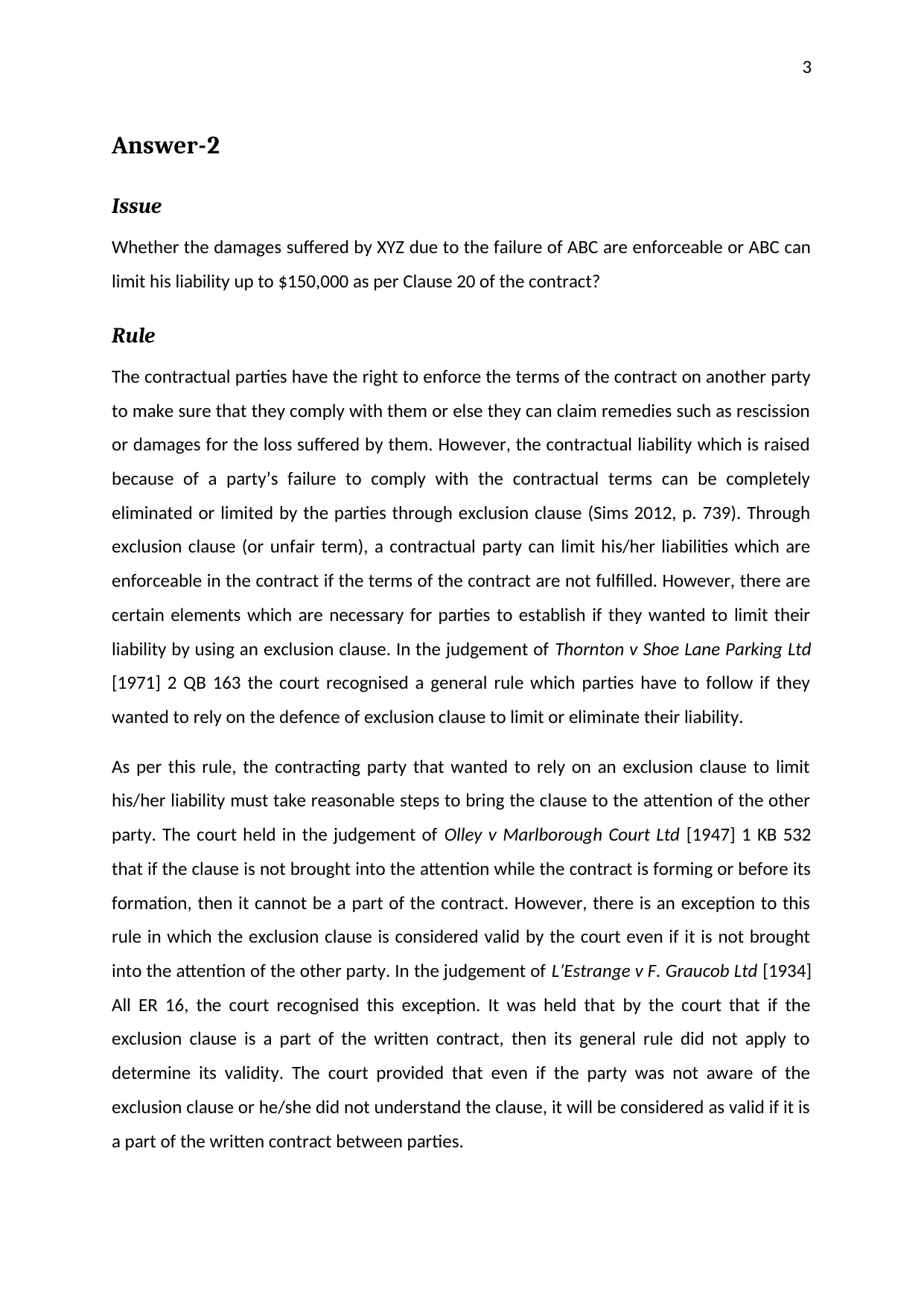
3
Answer-2
Issue
Whether the damages suffered by XYZ due to the failure of ABC are enforceable or ABC can
limit his liability up to $150,000 as per Clause 20 of the contract?
Rule
The contractual parties have the right to enforce the terms of the contract on another party
to make sure that they comply with them or else they can claim remedies such as rescission
or damages for the loss suffered by them. However, the contractual liability which is raised
because of a party’s failure to comply with the contractual terms can be completely
eliminated or limited by the parties through exclusion clause (Sims 2012, p. 739). Through
exclusion clause (or unfair term), a contractual party can limit his/her liabilities which are
enforceable in the contract if the terms of the contract are not fulfilled. However, there are
certain elements which are necessary for parties to establish if they wanted to limit their
liability by using an exclusion clause. In the judgement of Thornton v Shoe Lane Parking Ltd
[1971] 2 QB 163 the court recognised a general rule which parties have to follow if they
wanted to rely on the defence of exclusion clause to limit or eliminate their liability.
As per this rule, the contracting party that wanted to rely on an exclusion clause to limit
his/her liability must take reasonable steps to bring the clause to the attention of the other
party. The court held in the judgement of Olley v Marlborough Court Ltd [1947] 1 KB 532
that if the clause is not brought into the attention while the contract is forming or before its
formation, then it cannot be a part of the contract. However, there is an exception to this
rule in which the exclusion clause is considered valid by the court even if it is not brought
into the attention of the other party. In the judgement of L’Estrange v F. Graucob Ltd [1934]
All ER 16, the court recognised this exception. It was held that by the court that if the
exclusion clause is a part of the written contract, then its general rule did not apply to
determine its validity. The court provided that even if the party was not aware of the
exclusion clause or he/she did not understand the clause, it will be considered as valid if it is
a part of the written contract between parties.
Answer-2
Issue
Whether the damages suffered by XYZ due to the failure of ABC are enforceable or ABC can
limit his liability up to $150,000 as per Clause 20 of the contract?
Rule
The contractual parties have the right to enforce the terms of the contract on another party
to make sure that they comply with them or else they can claim remedies such as rescission
or damages for the loss suffered by them. However, the contractual liability which is raised
because of a party’s failure to comply with the contractual terms can be completely
eliminated or limited by the parties through exclusion clause (Sims 2012, p. 739). Through
exclusion clause (or unfair term), a contractual party can limit his/her liabilities which are
enforceable in the contract if the terms of the contract are not fulfilled. However, there are
certain elements which are necessary for parties to establish if they wanted to limit their
liability by using an exclusion clause. In the judgement of Thornton v Shoe Lane Parking Ltd
[1971] 2 QB 163 the court recognised a general rule which parties have to follow if they
wanted to rely on the defence of exclusion clause to limit or eliminate their liability.
As per this rule, the contracting party that wanted to rely on an exclusion clause to limit
his/her liability must take reasonable steps to bring the clause to the attention of the other
party. The court held in the judgement of Olley v Marlborough Court Ltd [1947] 1 KB 532
that if the clause is not brought into the attention while the contract is forming or before its
formation, then it cannot be a part of the contract. However, there is an exception to this
rule in which the exclusion clause is considered valid by the court even if it is not brought
into the attention of the other party. In the judgement of L’Estrange v F. Graucob Ltd [1934]
All ER 16, the court recognised this exception. It was held that by the court that if the
exclusion clause is a part of the written contract, then its general rule did not apply to
determine its validity. The court provided that even if the party was not aware of the
exclusion clause or he/she did not understand the clause, it will be considered as valid if it is
a part of the written contract between parties.
Secure Best Marks with AI Grader
Need help grading? Try our AI Grader for instant feedback on your assignments.
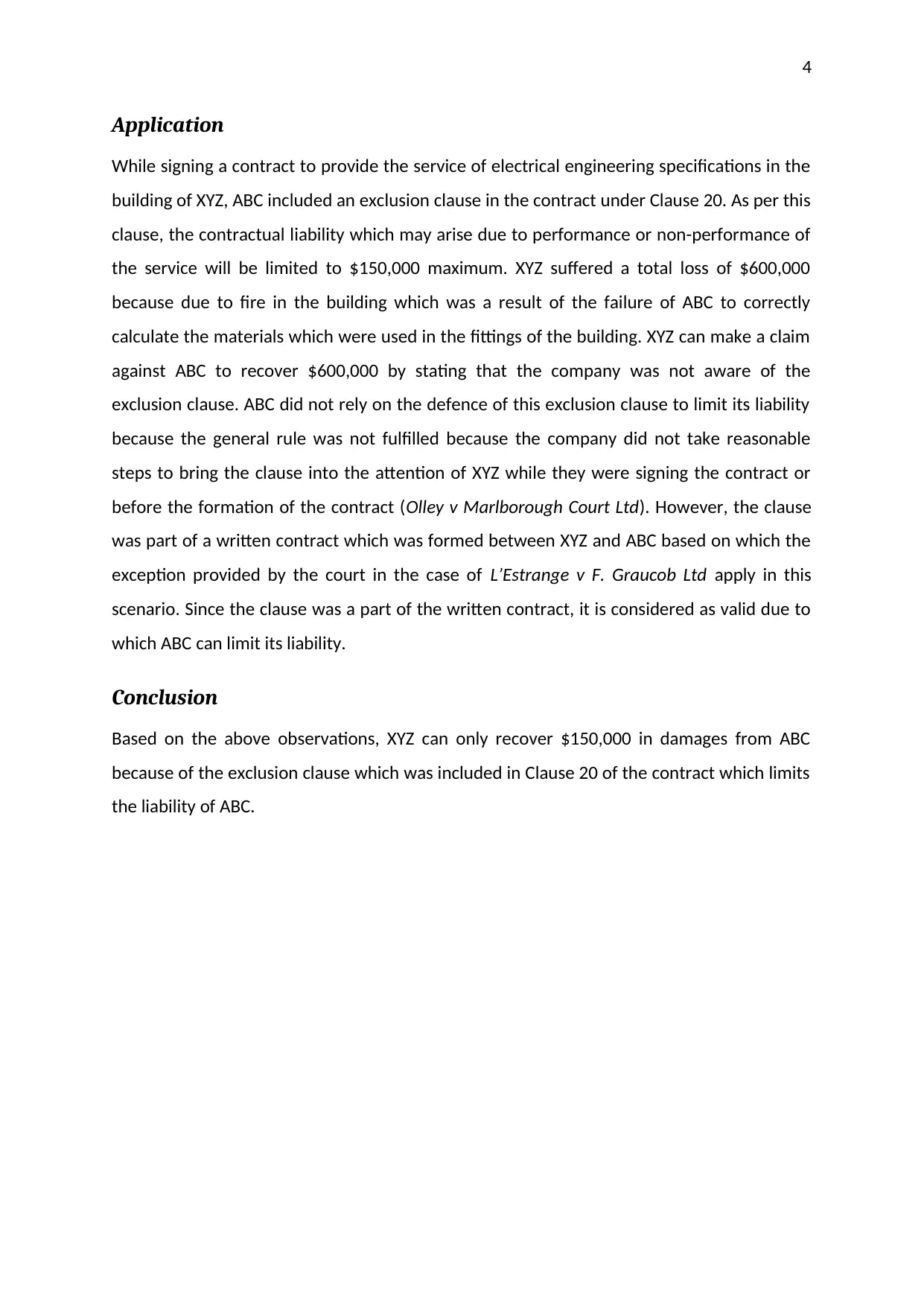
4
Application
While signing a contract to provide the service of electrical engineering specifications in the
building of XYZ, ABC included an exclusion clause in the contract under Clause 20. As per this
clause, the contractual liability which may arise due to performance or non-performance of
the service will be limited to $150,000 maximum. XYZ suffered a total loss of $600,000
because due to fire in the building which was a result of the failure of ABC to correctly
calculate the materials which were used in the fittings of the building. XYZ can make a claim
against ABC to recover $600,000 by stating that the company was not aware of the
exclusion clause. ABC did not rely on the defence of this exclusion clause to limit its liability
because the general rule was not fulfilled because the company did not take reasonable
steps to bring the clause into the attention of XYZ while they were signing the contract or
before the formation of the contract (Olley v Marlborough Court Ltd). However, the clause
was part of a written contract which was formed between XYZ and ABC based on which the
exception provided by the court in the case of L’Estrange v F. Graucob Ltd apply in this
scenario. Since the clause was a part of the written contract, it is considered as valid due to
which ABC can limit its liability.
Conclusion
Based on the above observations, XYZ can only recover $150,000 in damages from ABC
because of the exclusion clause which was included in Clause 20 of the contract which limits
the liability of ABC.
Application
While signing a contract to provide the service of electrical engineering specifications in the
building of XYZ, ABC included an exclusion clause in the contract under Clause 20. As per this
clause, the contractual liability which may arise due to performance or non-performance of
the service will be limited to $150,000 maximum. XYZ suffered a total loss of $600,000
because due to fire in the building which was a result of the failure of ABC to correctly
calculate the materials which were used in the fittings of the building. XYZ can make a claim
against ABC to recover $600,000 by stating that the company was not aware of the
exclusion clause. ABC did not rely on the defence of this exclusion clause to limit its liability
because the general rule was not fulfilled because the company did not take reasonable
steps to bring the clause into the attention of XYZ while they were signing the contract or
before the formation of the contract (Olley v Marlborough Court Ltd). However, the clause
was part of a written contract which was formed between XYZ and ABC based on which the
exception provided by the court in the case of L’Estrange v F. Graucob Ltd apply in this
scenario. Since the clause was a part of the written contract, it is considered as valid due to
which ABC can limit its liability.
Conclusion
Based on the above observations, XYZ can only recover $150,000 in damages from ABC
because of the exclusion clause which was included in Clause 20 of the contract which limits
the liability of ABC.
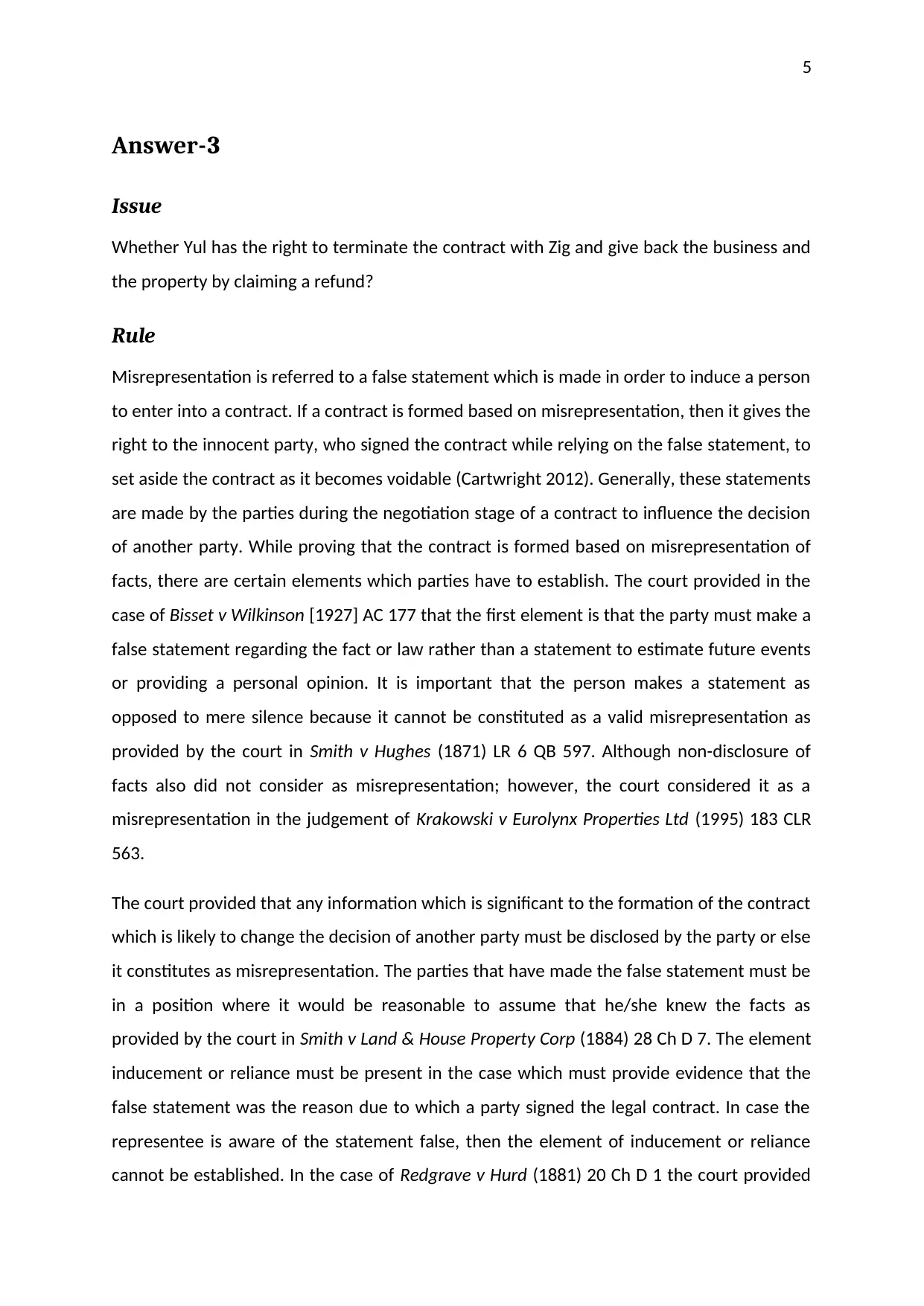
5
Answer-3
Issue
Whether Yul has the right to terminate the contract with Zig and give back the business and
the property by claiming a refund?
Rule
Misrepresentation is referred to a false statement which is made in order to induce a person
to enter into a contract. If a contract is formed based on misrepresentation, then it gives the
right to the innocent party, who signed the contract while relying on the false statement, to
set aside the contract as it becomes voidable (Cartwright 2012). Generally, these statements
are made by the parties during the negotiation stage of a contract to influence the decision
of another party. While proving that the contract is formed based on misrepresentation of
facts, there are certain elements which parties have to establish. The court provided in the
case of Bisset v Wilkinson [1927] AC 177 that the first element is that the party must make a
false statement regarding the fact or law rather than a statement to estimate future events
or providing a personal opinion. It is important that the person makes a statement as
opposed to mere silence because it cannot be constituted as a valid misrepresentation as
provided by the court in Smith v Hughes (1871) LR 6 QB 597. Although non-disclosure of
facts also did not consider as misrepresentation; however, the court considered it as a
misrepresentation in the judgement of Krakowski v Eurolynx Properties Ltd (1995) 183 CLR
563.
The court provided that any information which is significant to the formation of the contract
which is likely to change the decision of another party must be disclosed by the party or else
it constitutes as misrepresentation. The parties that have made the false statement must be
in a position where it would be reasonable to assume that he/she knew the facts as
provided by the court in Smith v Land & House Property Corp (1884) 28 Ch D 7. The element
inducement or reliance must be present in the case which must provide evidence that the
false statement was the reason due to which a party signed the legal contract. In case the
representee is aware of the statement false, then the element of inducement or reliance
cannot be established. In the case of Redgrave v Hurd (1881) 20 Ch D 1 the court provided
Answer-3
Issue
Whether Yul has the right to terminate the contract with Zig and give back the business and
the property by claiming a refund?
Rule
Misrepresentation is referred to a false statement which is made in order to induce a person
to enter into a contract. If a contract is formed based on misrepresentation, then it gives the
right to the innocent party, who signed the contract while relying on the false statement, to
set aside the contract as it becomes voidable (Cartwright 2012). Generally, these statements
are made by the parties during the negotiation stage of a contract to influence the decision
of another party. While proving that the contract is formed based on misrepresentation of
facts, there are certain elements which parties have to establish. The court provided in the
case of Bisset v Wilkinson [1927] AC 177 that the first element is that the party must make a
false statement regarding the fact or law rather than a statement to estimate future events
or providing a personal opinion. It is important that the person makes a statement as
opposed to mere silence because it cannot be constituted as a valid misrepresentation as
provided by the court in Smith v Hughes (1871) LR 6 QB 597. Although non-disclosure of
facts also did not consider as misrepresentation; however, the court considered it as a
misrepresentation in the judgement of Krakowski v Eurolynx Properties Ltd (1995) 183 CLR
563.
The court provided that any information which is significant to the formation of the contract
which is likely to change the decision of another party must be disclosed by the party or else
it constitutes as misrepresentation. The parties that have made the false statement must be
in a position where it would be reasonable to assume that he/she knew the facts as
provided by the court in Smith v Land & House Property Corp (1884) 28 Ch D 7. The element
inducement or reliance must be present in the case which must provide evidence that the
false statement was the reason due to which a party signed the legal contract. In case the
representee is aware of the statement false, then the element of inducement or reliance
cannot be established. In the case of Redgrave v Hurd (1881) 20 Ch D 1 the court provided
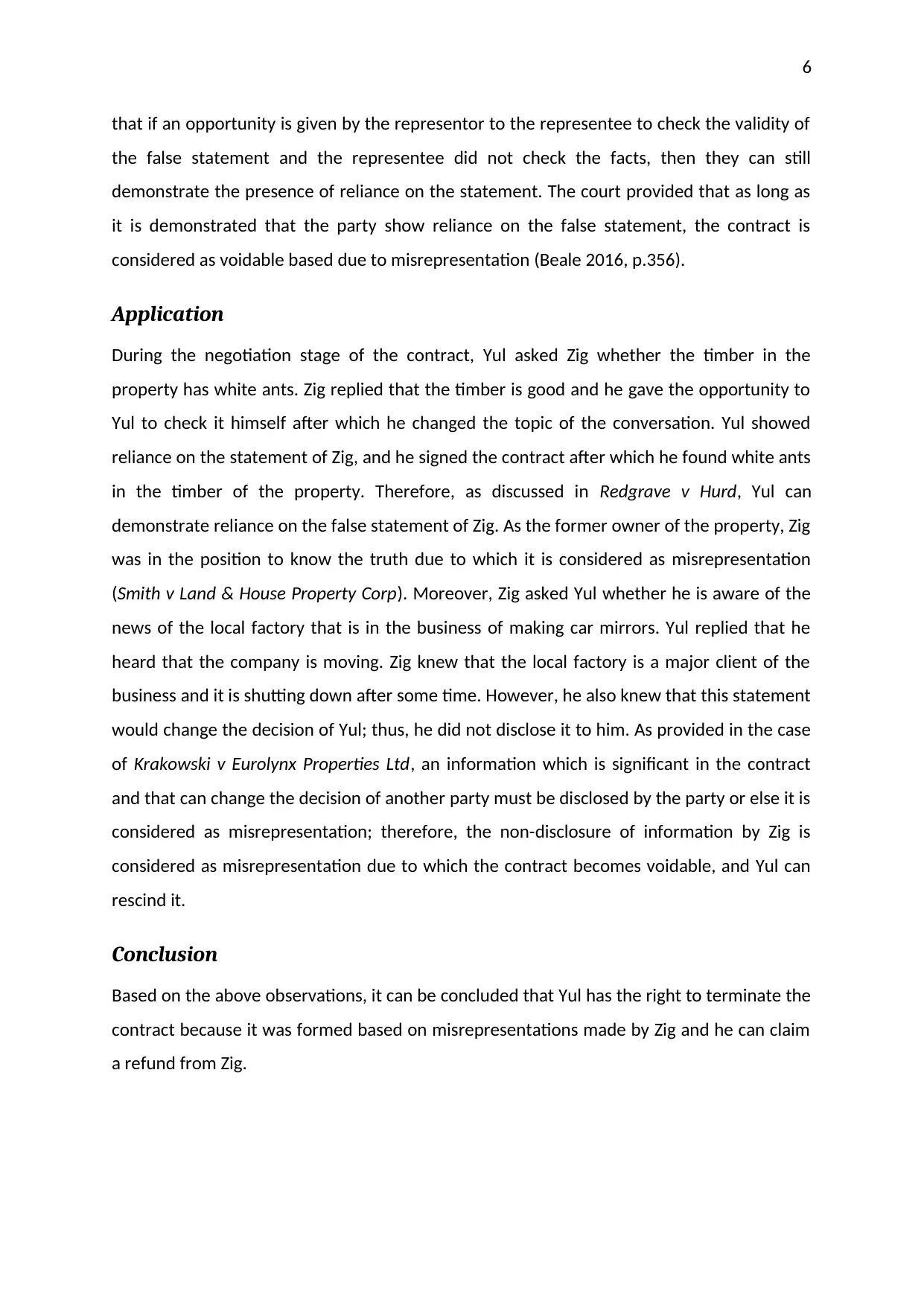
6
that if an opportunity is given by the representor to the representee to check the validity of
the false statement and the representee did not check the facts, then they can still
demonstrate the presence of reliance on the statement. The court provided that as long as
it is demonstrated that the party show reliance on the false statement, the contract is
considered as voidable based due to misrepresentation (Beale 2016, p.356).
Application
During the negotiation stage of the contract, Yul asked Zig whether the timber in the
property has white ants. Zig replied that the timber is good and he gave the opportunity to
Yul to check it himself after which he changed the topic of the conversation. Yul showed
reliance on the statement of Zig, and he signed the contract after which he found white ants
in the timber of the property. Therefore, as discussed in Redgrave v Hurd, Yul can
demonstrate reliance on the false statement of Zig. As the former owner of the property, Zig
was in the position to know the truth due to which it is considered as misrepresentation
(Smith v Land & House Property Corp). Moreover, Zig asked Yul whether he is aware of the
news of the local factory that is in the business of making car mirrors. Yul replied that he
heard that the company is moving. Zig knew that the local factory is a major client of the
business and it is shutting down after some time. However, he also knew that this statement
would change the decision of Yul; thus, he did not disclose it to him. As provided in the case
of Krakowski v Eurolynx Properties Ltd, an information which is significant in the contract
and that can change the decision of another party must be disclosed by the party or else it is
considered as misrepresentation; therefore, the non-disclosure of information by Zig is
considered as misrepresentation due to which the contract becomes voidable, and Yul can
rescind it.
Conclusion
Based on the above observations, it can be concluded that Yul has the right to terminate the
contract because it was formed based on misrepresentations made by Zig and he can claim
a refund from Zig.
that if an opportunity is given by the representor to the representee to check the validity of
the false statement and the representee did not check the facts, then they can still
demonstrate the presence of reliance on the statement. The court provided that as long as
it is demonstrated that the party show reliance on the false statement, the contract is
considered as voidable based due to misrepresentation (Beale 2016, p.356).
Application
During the negotiation stage of the contract, Yul asked Zig whether the timber in the
property has white ants. Zig replied that the timber is good and he gave the opportunity to
Yul to check it himself after which he changed the topic of the conversation. Yul showed
reliance on the statement of Zig, and he signed the contract after which he found white ants
in the timber of the property. Therefore, as discussed in Redgrave v Hurd, Yul can
demonstrate reliance on the false statement of Zig. As the former owner of the property, Zig
was in the position to know the truth due to which it is considered as misrepresentation
(Smith v Land & House Property Corp). Moreover, Zig asked Yul whether he is aware of the
news of the local factory that is in the business of making car mirrors. Yul replied that he
heard that the company is moving. Zig knew that the local factory is a major client of the
business and it is shutting down after some time. However, he also knew that this statement
would change the decision of Yul; thus, he did not disclose it to him. As provided in the case
of Krakowski v Eurolynx Properties Ltd, an information which is significant in the contract
and that can change the decision of another party must be disclosed by the party or else it is
considered as misrepresentation; therefore, the non-disclosure of information by Zig is
considered as misrepresentation due to which the contract becomes voidable, and Yul can
rescind it.
Conclusion
Based on the above observations, it can be concluded that Yul has the right to terminate the
contract because it was formed based on misrepresentations made by Zig and he can claim
a refund from Zig.
Paraphrase This Document
Need a fresh take? Get an instant paraphrase of this document with our AI Paraphraser
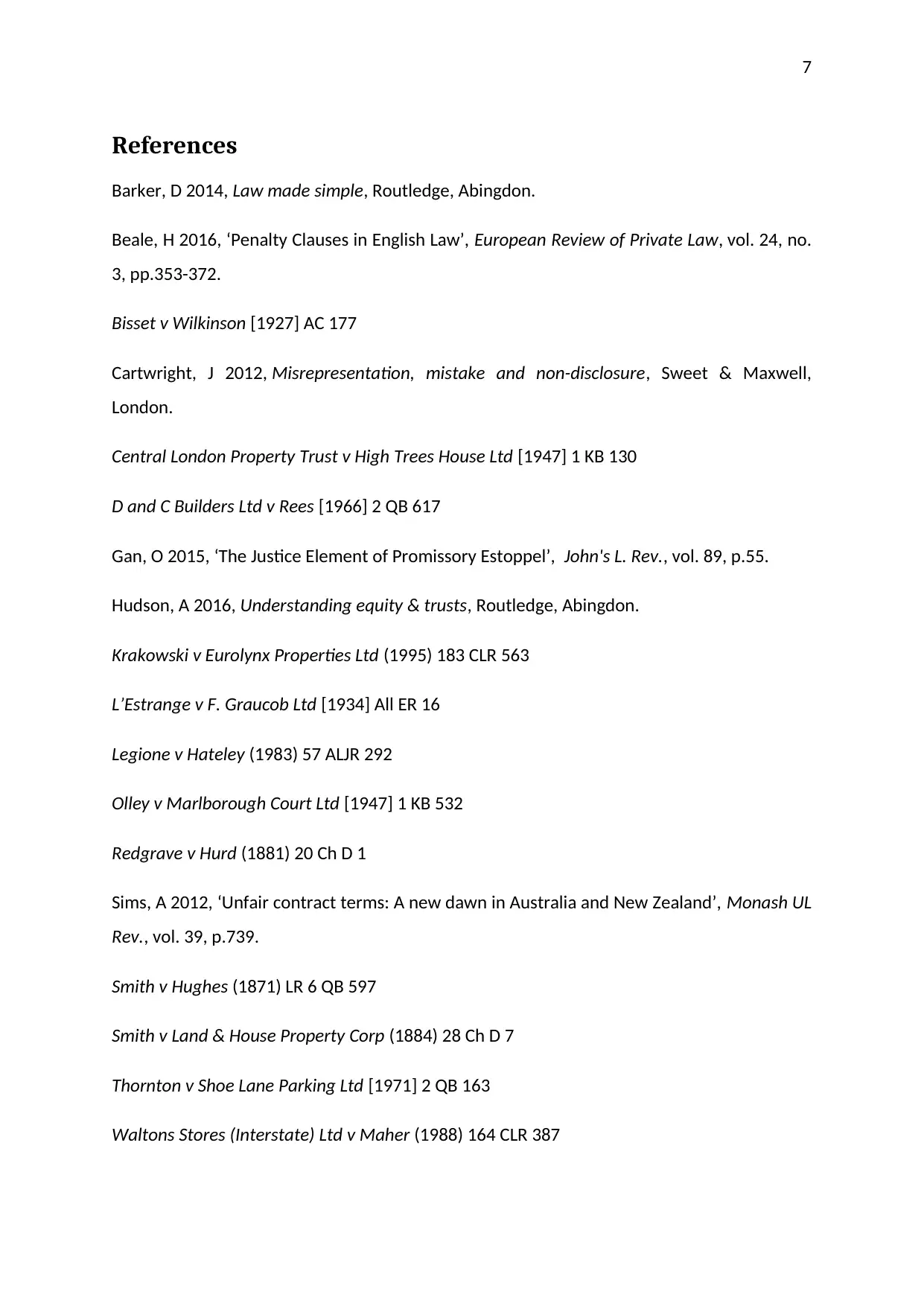
7
References
Barker, D 2014, Law made simple, Routledge, Abingdon.
Beale, H 2016, ‘Penalty Clauses in English Law’, European Review of Private Law, vol. 24, no.
3, pp.353-372.
Bisset v Wilkinson [1927] AC 177
Cartwright, J 2012, Misrepresentation, mistake and non-disclosure, Sweet & Maxwell,
London.
Central London Property Trust v High Trees House Ltd [1947] 1 KB 130
D and C Builders Ltd v Rees [1966] 2 QB 617
Gan, O 2015, ‘The Justice Element of Promissory Estoppel’, John's L. Rev., vol. 89, p.55.
Hudson, A 2016, Understanding equity & trusts, Routledge, Abingdon.
Krakowski v Eurolynx Properties Ltd (1995) 183 CLR 563
L’Estrange v F. Graucob Ltd [1934] All ER 16
Legione v Hateley (1983) 57 ALJR 292
Olley v Marlborough Court Ltd [1947] 1 KB 532
Redgrave v Hurd (1881) 20 Ch D 1
Sims, A 2012, ‘Unfair contract terms: A new dawn in Australia and New Zealand’, Monash UL
Rev., vol. 39, p.739.
Smith v Hughes (1871) LR 6 QB 597
Smith v Land & House Property Corp (1884) 28 Ch D 7
Thornton v Shoe Lane Parking Ltd [1971] 2 QB 163
Waltons Stores (Interstate) Ltd v Maher (1988) 164 CLR 387
References
Barker, D 2014, Law made simple, Routledge, Abingdon.
Beale, H 2016, ‘Penalty Clauses in English Law’, European Review of Private Law, vol. 24, no.
3, pp.353-372.
Bisset v Wilkinson [1927] AC 177
Cartwright, J 2012, Misrepresentation, mistake and non-disclosure, Sweet & Maxwell,
London.
Central London Property Trust v High Trees House Ltd [1947] 1 KB 130
D and C Builders Ltd v Rees [1966] 2 QB 617
Gan, O 2015, ‘The Justice Element of Promissory Estoppel’, John's L. Rev., vol. 89, p.55.
Hudson, A 2016, Understanding equity & trusts, Routledge, Abingdon.
Krakowski v Eurolynx Properties Ltd (1995) 183 CLR 563
L’Estrange v F. Graucob Ltd [1934] All ER 16
Legione v Hateley (1983) 57 ALJR 292
Olley v Marlborough Court Ltd [1947] 1 KB 532
Redgrave v Hurd (1881) 20 Ch D 1
Sims, A 2012, ‘Unfair contract terms: A new dawn in Australia and New Zealand’, Monash UL
Rev., vol. 39, p.739.
Smith v Hughes (1871) LR 6 QB 597
Smith v Land & House Property Corp (1884) 28 Ch D 7
Thornton v Shoe Lane Parking Ltd [1971] 2 QB 163
Waltons Stores (Interstate) Ltd v Maher (1988) 164 CLR 387

8
1 out of 9
Related Documents
Your All-in-One AI-Powered Toolkit for Academic Success.
+13062052269
info@desklib.com
Available 24*7 on WhatsApp / Email
![[object Object]](/_next/static/media/star-bottom.7253800d.svg)
Unlock your academic potential
© 2024 | Zucol Services PVT LTD | All rights reserved.





